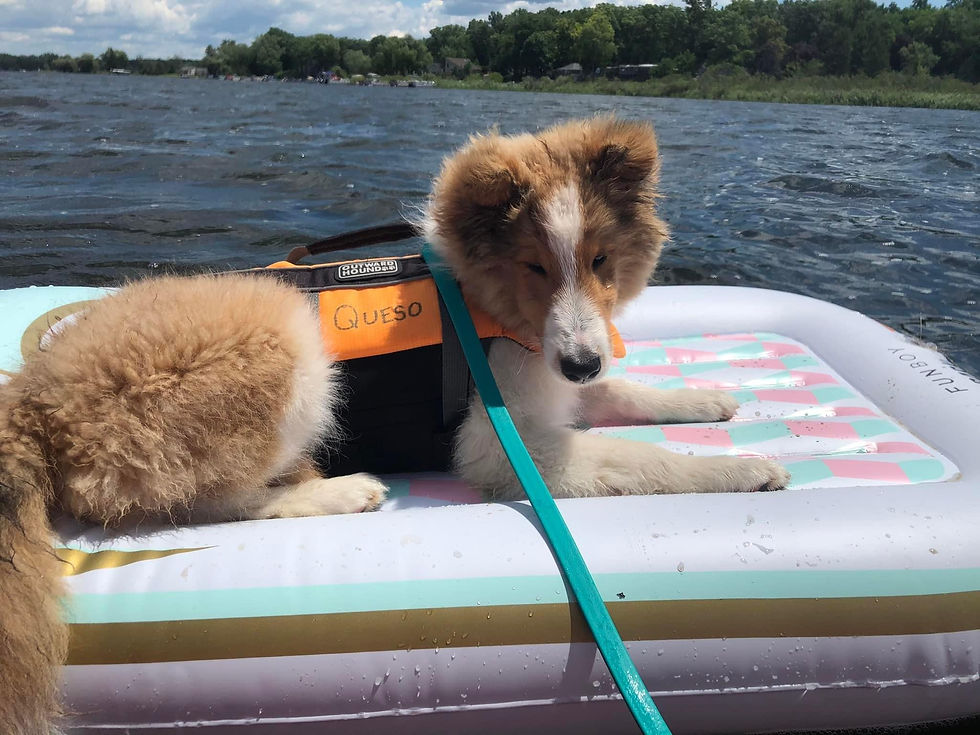Water Safety for Pets
- Emma Tinklenberg NCMG

- Apr 17, 2024
- 3 min read
Pools, lakes, streams, and hoses can be the highlight of a dog’s day! Give a dog water on a hot summer day and they are often thrilled to jump in and play.
However, with such a high reward activity there is often a higher risk of danger.
Safety precautions around water should always be taken seriously, not just for people but for our pets as well.
Swimming! It is a common myth to assume that all dogs know how to swim. Some breeds will have a natural predisposition to swimming while others have little to no instinct.
Investing in a life jacket for your dog - even dogs that know how to swim - is a very wise precaution.
Beyond swimming skills or lack thereof, there are many other risks with water activities.

Water intoxication is a massive risk for high drive dogs that may enjoy chomping at the hose or swallowing great quantities of water. Water intoxication can happen when the dog ingests too much water at once, depleting sodium levels outside the cells (hyponatremia) and causing the body to attempt to rebalance itself and increase fluid intake inside the cells. This is especially true of salt water!
This leads to an emergency situation requiring immediate veterinary care. Symptoms of water intoxication include lethargy, bloating, pale gums, loss of coordination, drooling, glazed eyes, and even vomiting or seizures.
Prevention is key; avoid letting your dog chomp at the hose and only give water in small quantities if your dog has a hard time regulating their drinking.
Drinking too much too quickly can also induce regurgitation which can then lead to dehydration and even aspiration. In hot summer months, this can quickly contribute to heat exhaustion and heat stroke. Rehydrating slowly and consistently in small quantities is important!
Aspiration can happen if a dog ingests too much water too fast and regurgitates; they can risk inhaling the regurgitated fluid. Fluid in the lungs can lead to serious infections and pneumonia and require immediate veterinary care. Choking and breathing water directly into the lungs can have the same effect.

Watch your dog’s swimming style - dogs who keep their head low with an open mouth are more at risk of ingesting water. A life vest with a floatation pad under the neck can help keep the dogs head up.
Watch the size and shape of toys! Round and large toys (tennis balls!) will cause a dog’s mouth to open wide and leave room for water to enter the mouth. Flat toys (frisbees or bumpers) will minimize water intake.
Water quality is important to note. Dogs should not drink from pools as chlorine and other pool chemicals can be harmful. Provide fresh water away from the pool and encourage dogs to drink from those sources instead.

Lakes and ponds run the risk of harmful algal blooms like red tides and blue-green algae. These can be highly toxic and cause neurological issues such as seizures and loss of coordination as well as respiratory issues, liver damage, and can be fatal.
Learning to spot cyanobacteria (blue-green algae) is a very useful skill as it can appear similar to things like duck weed and green algae.
Cyanobacteria poisoning happens fast! Always know your nearest emergency vet clinic and pay close attention to your dog especially when they have access to water!
Rivers and streams have currents that can require strong swimming skills.
Oceans and salt water can lead to dehydration and hyponatremia as noted above.
Be aware of the wildlife around the environment - creatures like snapping turtles, fish, geese, and swans can be massive hazards.
Other hazards in wild places include old fishing lines, broken shells, washed up fish, and so many other things can be hazardous or toxic to our pets. Be aware of places with flooding that may have drains where your pet could get trapped or stuck.
Water safety is not exclusive to warm months; frozen lakes and other bodies of water are incredibly dangerous for dogs as this can lead to slips and falls as well as breaking through the ice and risking hypothermia and drowning.

This is a long list of hazards that may scare you away from water based activities with dogs. Like every activity with your pet, there are always risks and rewards to consider.
Allowing access to water can be one of the most enriching and rewarding experiences for our dogs! It can boost confidence, strengthen muscles, and can be amazing for their overall physical and mental health.
Our job as pet owners is to make sure we are keeping things safe! Prevention is the greatest tool we have for so many of these water related risks. Knowing basic canine first aid and CPR as well as knowing your nearest emergency clinic are critical skills to have and maintain.
We hope everyone has a safe and FUN summer!





Comments